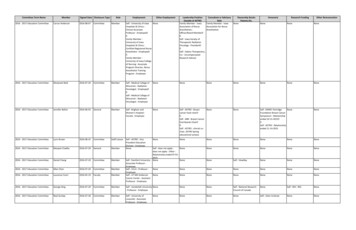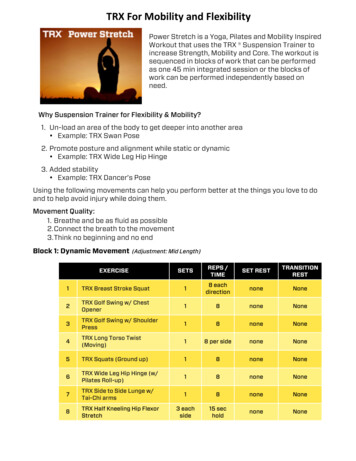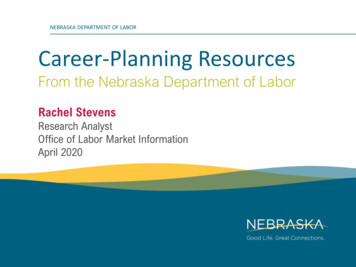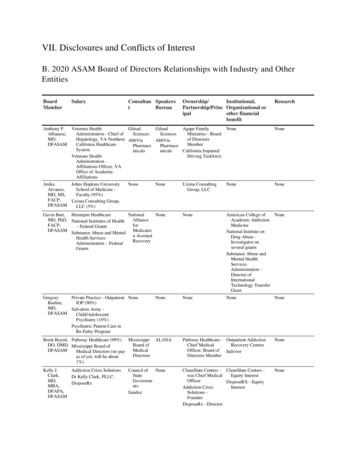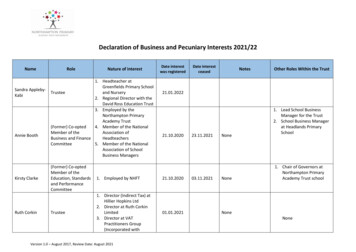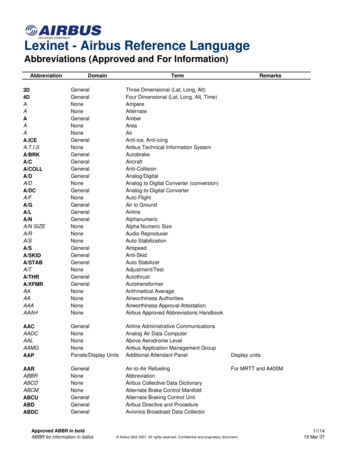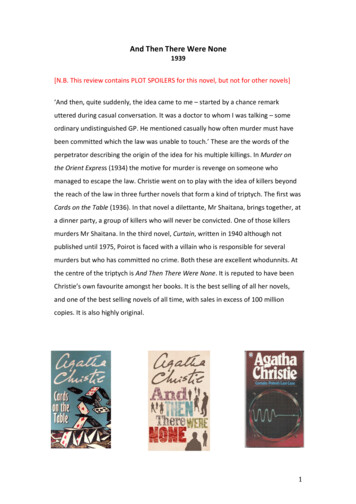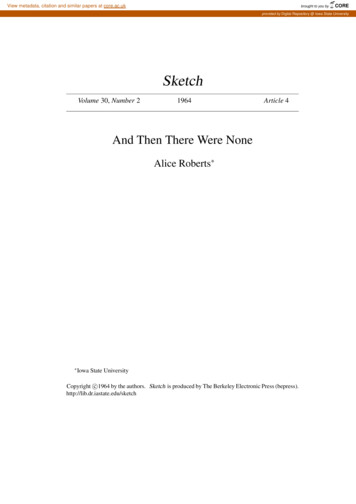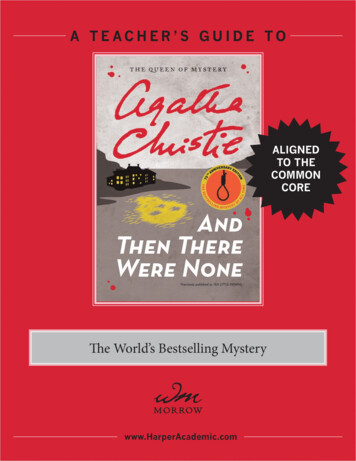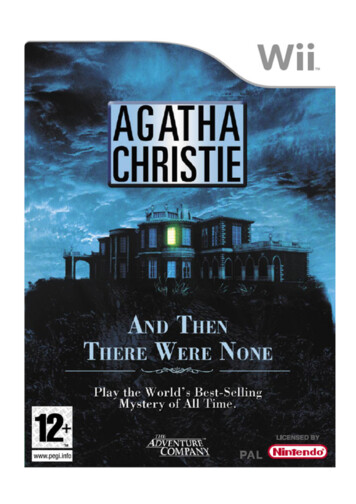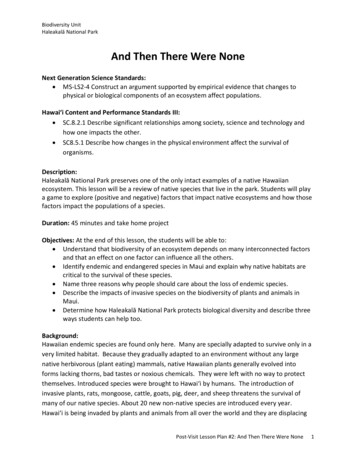
Transcription
Biodiversity UnitHaleakalā National ParkAnd Then There Were NoneNext Generation Science Standards: MS-LS2-4 Construct an argument supported by empirical evidence that changes tophysical or biological components of an ecosystem affect populations.Hawai‘i Content and Performance Standards III: SC.8.2.1 Describe significant relationships among society, science and technology andhow one impacts the other. SC8.5.1 Describe how changes in the physical environment affect the survival oforganisms.Description:Haleakalā National Park preserves one of the only intact examples of a native Hawaiianecosystem. This lesson will be a review of native species that live in the park. Students will playa game to explore (positive and negative) factors that impact native ecosystems and how thosefactors impact the populations of a species.Duration: 45 minutes and take home projectObjectives: At the end of this lesson, the students will be able to: Understand that biodiversity of an ecosystem depends on many interconnected factorsand that an effect on one factor can influence all the others. Identify endemic and endangered species in Maui and explain why native habitats arecritical to the survival of these species. Name three reasons why people should care about the loss of endemic species. Describe the impacts of invasive species on the biodiversity of plants and animals inMaui. Determine how Haleakalā National Park protects biological diversity and describe threeways students can help too.Background:Hawaiian endemic species are found only here. Many are specially adapted to survive only in avery limited habitat. Because they gradually adapted to an environment without any largenative herbivorous (plant eating) mammals, native Hawaiian plants generally evolved intoforms lacking thorns, bad tastes or noxious chemicals. They were left with no way to protectthemselves. Introduced species were brought to Hawaiʻi by humans. The introduction ofinvasive plants, rats, mongoose, cattle, goats, pig, deer, and sheep threatens the survival ofmany of our native species. About 20 new non-native species are introduced every year.Hawaiʻi is being invaded by plants and animals from all over the world and they are displacingPost-Visit Lesson Plan #2: And Then There Were None1
Biodiversity UnitHaleakalā National Parknative species that have nowhere else to go. There are many ways that we can help to fight thismajor threat to our endemic biodiversity. Haleakalā National Park is at the forefront of thisbattle against invasive species.Vocabulary:Endemic: Native species that have adapted to a specific region over time and are foundnowhere else.Organism: An individual animal, plant, or single-celled life form.Population: The number of individuals of one or more species living in a place at a given time.Symbiotic: An interdependent relationship that benefits both organisms.Materials Needed:Species cards (included)Threats and Aids list (for teacher) (2 sided, included)1 blank sheet of paper for each studentScissorsProcedure:Step 1: IntroductionCopy and cut the 12 “species” cards apart and distribute one to each student.Explain that each student is an endemic plant or animal and they are speciallyadapted to live only here on Maui. Review the terms endemic and adaptation tocheck for understanding. Explain that many endemic species depend on one ormore other specialized endemic species for their survival. They often areinterdependent and help each other in symbiotic relationships.Step 2: PreparationHave each student cut apart a blank piece of paper into six even size pieces.Each slip of paper represents 1/6th of the population of their endemic species.Each student will hold 6 slips of paper, representing the entire population of thatspecies. The Threats and Aids List is for the teacher to read as the gameprogresses. Choose an area of the room for a “graveyard” for extinct species.Step 3: Species ReviewSpend some time discussing the different native plant and animal species thatare on the species cards. Native Plants: ‘A‘ali‘i, Nohoanu, Pūkiawe, ‘Ama‘u, ‘Ākala, ‘Iliahi,Māmane, ‘Ōhi‘a lehua, and ‘Āhinahina Native Birds: ʻIʻiwi, Nēnē, and ‘ApapaneAsk students if they have any questions about their species. Students will needto be somewhat familiar with their species to understand when a “threat” or“aid” will affect them. Discuss some of the threats facing Maui’s endemicPost-Visit Lesson Plan #2: And Then There Were None2
Biodiversity UnitHaleakalā National Parkspecies.Step 4: Game InstructionsTell students that you are going to be exploring what factors cause a species tobecome endangered or extinct? Give them the following directions: Everyone stand up by your desk holding your 6 slips of paper. Eachslip of paper represents 1/6th of the entire population of yourparticular species. Each time that I read a “threat” that affects yourspecific species put one of your slips on your desk. Only the speciesaffected by the “threat” should put a slip on their desk. This meansthat your species populations are declining. Whenever I say, “Human Population Growth,” everyone turns in aslip. Your populations are declining again. Whenever I read a statement that helps your species survive from the“aid” list take a slip of paper back. This represents a populationrecovery (increase). (For an optimistic and inspiring ending: continue on using all “aid”factors to save the endangered and threatened species from the brinkof disaster.) When you have only two slips of paper left, sit down in your chair andsay. “I am threatened”. When you have only one slip left, stay seated and say “I amendangered”. When you are completely out of slips, move to the “graveyard” areaand say “I am extinct”. Extinction is final.Continue to play until you have a mix of threatened, endangered, and extinctstudents. Write the words Thriving, Threatened, Endangered, and Extinct on thewhite board. Then write on the board the tally of the number of students(species) remaining in each category.Step 5: Discuss and SummarizeTell students that their populations became “threatened” when their populationbecame somewhat small in number. They became “endangered” when theirpopulations became so small that they were in danger of extinction. Extinction iswhen there are no individuals left. Extinction is final. The plant or animal is “goneforever.” Summarize this lesson with a discussion. Some thought provokingdiscussion questions are: How many of you have slips left? How many have none? Is this game life-like? Why or why not?Post-Visit Lesson Plan #2: And Then There Were None3
Biodiversity UnitHaleakalā National Park How could you find out if the species you had is actuallythreatened/endangered/extinct?Do species have any choices in how big their populations are? Why orwhy not?What are the important ideas in the game?What are some factors that influence the survival of populations ofplants and animals?Can you think of some survival factors that this game did notconsider?Do we have any control over any of these factors?Step 6: Journal EntrySome thought provoking journal questions are: How do changes in a species habitat affect their population? Givespecific examples. Why are native habitats critical to the survival of Maui’s endemicspecies? What factors affect the biodiversity of an ecosystem? When onefactor changes what can happen? How could a species adaptations help it to survive when itsenvironment changes? Explain using specific examples. How could modern technology help endangered species to survive? Name three reasons why people should care about the loss ofendemic species. Describe the impacts of invasive species on the biodiversity of plantsand animals in Maui. Give specific examples. How does Haleakalā National Park help to protect biological diversity?Name three things that you can do to help.Step 7: Design a Park Display (Take Home Project)You have been hired to design a park display to help inform 1,000,000 visitorsper year about biodiversity in Haleakalā National Park. Research HaleakalāNational Park and create a poster size display that gives solid facts about theparks biodiversity. Make sure to include lots of images in order to help visuallyeducate park visitors.Post-Visit Lesson Plan #2: And Then There Were None4
Biodiversity UnitHaleakalā National ParkSpecies anu‘Apapane‘ĀkalaPūkiawe‘Iliahi‘Ōhi‘a lehuaMāmane‘Ama‘uPost-Visit Lesson Plan #2: And Then There Were None5
Biodiversity UnitHaleakalā National ParkThreatsAidsYou have been poisoned by aEucalyptus tree.Volunteers removed a stand ofEucalyptus trees that were poisoningyour roots.Mosquitoes carry avian malaria, adisease affecting endemic birdspecies.People removed debris and standingwater from their yards somosquitoes can’t breed.Feral pigs move into your habitat and Pig hunters keep the populations oftrample it.pigs down.Pesticide spray that kills weeds, haspolluted the water.I live in a Pesticide free area withorganic farmers and a clean watersupply.An invasive plant is accidentlybrought into Maui from a visitor.Agricultural Inspectors at the airportcatch an invasive plant thathitchhiked on a visitor’s shoe.Ants and wasps enter your habitatand attack your pollinator.National Park Service staff set upwasp traps to catch them.Feral cats move into your habitat.A family of feral cats are turned in toMaui Humane Society for adoption.People feed you food that is notfrom your habitat.Visitors drive carefully and give youlots of space when they visit yourhabitat.Post-Visit Lesson Plan #2: And Then There Were None6
Biodiversity UnitHaleakalā National ParkThreatsAidsA group of Boy scouts planted 100Your habitat is threatened from treesnative trees in Haleakalā Nationalbeing cut down.Park.Goats and sheep affect your habitatby stripping the mountainside ofvegetation.National Park Service staff andvolunteers built a fence thatsurrounds my habitat and protectsme.Invasive plants crowd your habitat.People remove invasive plants fromtheir backyards.Rats and mongoose enter yourhabitat and eat bird eggs.National Park Service staff trap ratsand mongoose in your habitat.Miconia, an invasive plant, movesinto your habitat and shadeseverything.MISC (Maui Invasive Species Control)removed Miconia from your habitat.Pine trees form dense, nearlyimpenetrable thickets that don’tleave any room for you!Student volunteers cut down nonnative pine trees as a communityservice project.Pollution causes the air quality inyour habitat to degrade.A wealthy land owner donated 500acres to the National Park Service.Water is diverted or removed fromyour habitat for human use.Human use from a nearby stream islimited to help restore stream flow.Post-Visit Lesson Plan #2: And Then There Were None7
Post-Visit Lesson Plan #2: And Then There Were None 6 Threats Aids You have been poisoned by a Eucalyptus tree. Volunteers removed a stand of Eucalyptus trees that were poisoning your roots. Mosquitoes carry avian malaria, a disease affecting endemic bird species. People removed debris and standing water from their yards so
